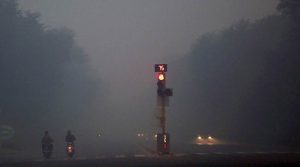Delhi Smog: Delhi must look for Solutions rather than passing blame on Farmers

First International Agro biodiversity Congress to kick off tomorrow
November 5, 2016
Strategic changes happening in Seeds and Agrochemical companies to control Agriculture
November 19, 2016Devinder Sharma
An interesting study by ‘India Spend’ tells us that New Delhi’s air quality prior to Diwali, October 30, was better this year than what it was in 2015. The morning after Diwali, Delhi’s air quality worsened 29 times. This conclusively proves that stubble burning in Punjab and Haryana was not responsible for choking Delhi. In any case, the peak period of stubble burning was prior to Diwali when air quality was rated better than last year. If stubble burning was the reason, the air quality before Diwali too should have deteriorated. So far, more than 60 per cent of wheat sowing is complete, so Delhi people cannot simply pass on the blame to farmers. Delhi didn’t turn into a ‘Gas Chamber’ overnight but has been a ‘Gas Chamber’ for more than 15 years now. Stubble burning lasts for about 15-20 days. Is delhi’s air quality clean for the remaining days of the year? Come on, lets accept it. People of Delhi are responsible for this. They must take the blame and do something to solve a problem which has been created by them only.

Delhi’s smog. Photo: Indian Express
This is not to justify stubble burning. But what needs to be understood is that stubble burning is a problem created by Combine-Harvesters. It is a problem created by a technology. Going by the Polluter Pays principle they should be asked to clean up. With the application of Combines increasing over the years, the problem of stubble burning is multiplying. Combine machines cut the spike of the paddy plant leaving the stem intact. Since cattle do not feed on paddy straw, farmers find it difficult to replough as the stubble doesn’t biodegrade. Farmers have no time to remove the stubble from the fields due to paucity of time since they have to prepare the land for wheat sowing. Moreover, it involves costs, something around Rs 5,000 per acre extra, which the Govts are reluctant to pay.
All the solutions being advocated to stop the stubble burning are very expensive, involve a number of machines, and are time consuming. Happy seeder machine, which actually is meant for zero tillage, is not helpful as the stubble collects making it difficult for the machine to operate. Farmers using Happy Seeder machines to do wheat sowing actually burn the stubble in most cases before using the machine. Using Straw reaper, Chopper, Reverse plough, Rotavator, is a very expensive option, requiring more time. It also needs the use of a heavy duty tractor, exceeding 60 HP.
Penalising farmers by imposing a penalty is not correct. NGT must review its decision in the light of the difficulties the farmers are encountering.
My suggestion: 1) Provide an incentive of Rs 5,000 per acre to the farmers for taking care of the stubble. 2) Govt can impose fine for stubble burning only after it meets the additional cost a farmer would incur. 3) Direct the Combine-Harvester manufacturers to make a technology intervention/improvement which enables chopping the plant stem from the base, and spreading the straw in the field or bundle the straw like a Bailer does. 4)Propagate a technology developed by the National Institute for Organic Farming which makes use of the straw for compost. Punjab soils need organic matter desperately and the effort should be to add as much organic content in the soil as possible.
(Writer is a researcher, columnist, author, crusader on the issues of food and agricultural policy. He can be followed on his blog ‘Ground Reality’)
——————————————————


